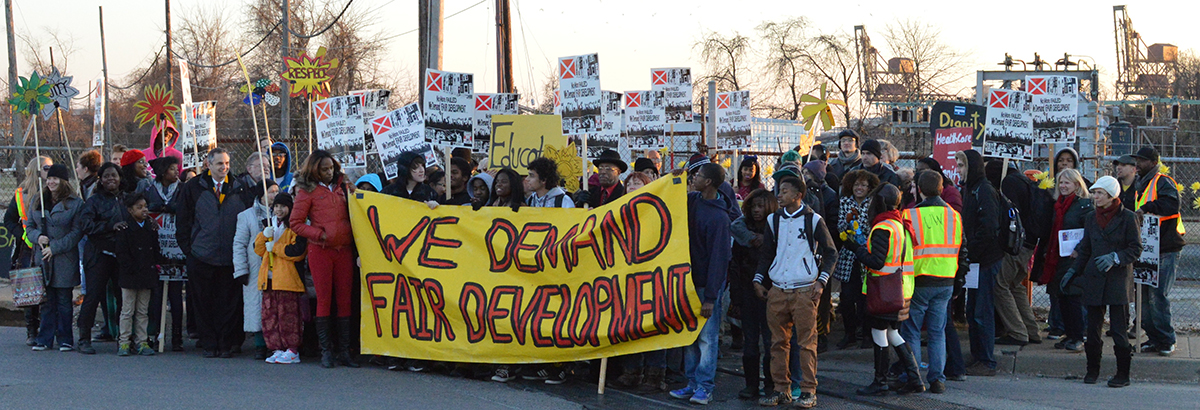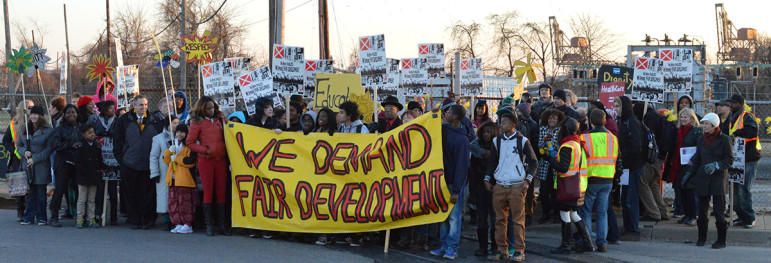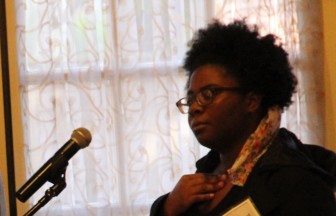By Christine Stoddard
MarylandReporter.com
Asked about the long-smoldering fight over a 160-megawatt trash incinerator proposed in south Baltimore, Gov. Larry Hogan said at a forum Wednesday that he has “no position on it because I don’t have the facts.”
Instead, he pointed to his administration’s “green agenda” and its plan to reduce phosphorus levels in the Chesapeake Bay.
“I’m sensitive to the environment, as long as we can do things for the environment that don’t kill the economy and jobs,” Hogan said.
The question at the Annapolis Summit of WEAA and the Daily Record came from Destiny Watford, 20, who grew up in Curtis Bay, the site of the proposed incinerator, one of the largest waste-to-energy plants in the country. (The question and answer at about 16:30 on the audio recording.)
In an interview afterward, Watford, a junior at Towson University, said she found Hogan’s reply “infuriating,” even though he promised to have his staff meet with her and the group opposing the incinerator.
“We’ve been fighting this proposal for four years,” said Watford. “This incinerator is going to emit brain-damaging mercury and lead in a place that already has some of the worst pollution in the area. And people there are getting lung cancer, asthma and other respiratory diseases because of it.”
Letter, protests and arrests at Department of Environment
Hogan may not have had the facts about the project, but his own environment secretary, Ben Grumbles, whom the governor called one of the best in the country, was well aware of the Curtis Bay project and the opposition to it.
In November, incinerator opponents went to the Maryland Department of the Environment headquarters in Baltimore to deliver a letter saying the permit for the project had expired and should be rescinded.
Grumbles then wrote to Energy Answers, the company behind the incinerator, on Nov. 24 to say it had not fulfilled its permit requirements to keep construction going and needed to submit documentation to prove it should be allowed to continue by Dec. 7.
On Dec. 15, 100 protesters rallied outside of the MDE headquarters to demand that the state revoke the permit. Seven were arrested. Fern Shen of Baltimore Brew reported on the demonstration and arrests, and also that Watford had personally met with Grumbles, who told he was giving Energy Answers until January to respond with further information.
Still under review
Department spokesman, Jay Apperson, said in an email: “The company responded in a Dec. 7 letter. The Department is currently reviewing the information submitted by the company. We hope to make a decision soon.”
Sen. Bill Ferguson, whose district includes Curtis Bay, said he was surprised last summer to find the project was still alive since construction had stopped.
Ferguson said there were many competing interests in the development plans that began under the O’Malley administration. The incinerator was designed to turn trash into electricity for plants that would be built on the site.
The building trades unions were anxious to have the construction jobs, and the Steelworkers were going to staff the plant. But the community around it was sharply opposed.
“It’s a mess,” said Ferguson. He believes that the low price of oil has reduced overall energy costs, and made the electricity from the incinerator too expensive to compete.
Watford is a member of Free Your Voice, a human rights group that claims the incinerator project will devastate the health of the local community. Energy Answers will be allowed to emit up to 1,000 pounds of lead and 240 pounds of mercury a year.
In 2011, the Baltimore Regional Cooperative Purchasing Committee announced that its members had agreed to 10-year deals to purchase power from the incinerator. But in March 2015, the City of Baltimore canceled its contract with Energy Answers due to the project’s repeated starts and stops in construction.
Causing disease
Watford said that she believes her neighbor, a close friend, died of lung cancer as a result of living in Curtis Bay for years. She also believes that her mother’s asthma has worsened because of the neighborhood’s polluted conditions.
“Gov. Hogan’s response is a poor development,” Watford said, “especially since our group and other community members have positive solutions that wouldn’t harm people’s health. That includes a proposal for a 97-acre solar farm in the spot where the incinerator is supposed to go. If that solar farm happened, it would be the largest on the Eastern Seaboard. There’s also talk of putting in composting facilities, a community garden and so many other ideas.”
Find out more
- We Demand Fair Development! Stop the Incinerator! – Free Your Voice website
- “Despite protests and delays, full-time construction of power plants set for 2016” – The Baltimore Sun






Large trash to energy converters have been successfully operated in Massachusetts and other states for over 35 years, without any ill effects.
Anyone who has ever toured Curtis Bay knows it’s an industrial area. At this point, it would be smart to MOVE all the human beings out. There are not that many left. That way, the small peninsula could be entirely industrial. the measly 100 protesters should tell everyone that this would be a beneficial project to tens of thousands. BTW, Solar farms on actual land are a waste of resources. Put them on roofs and garages!